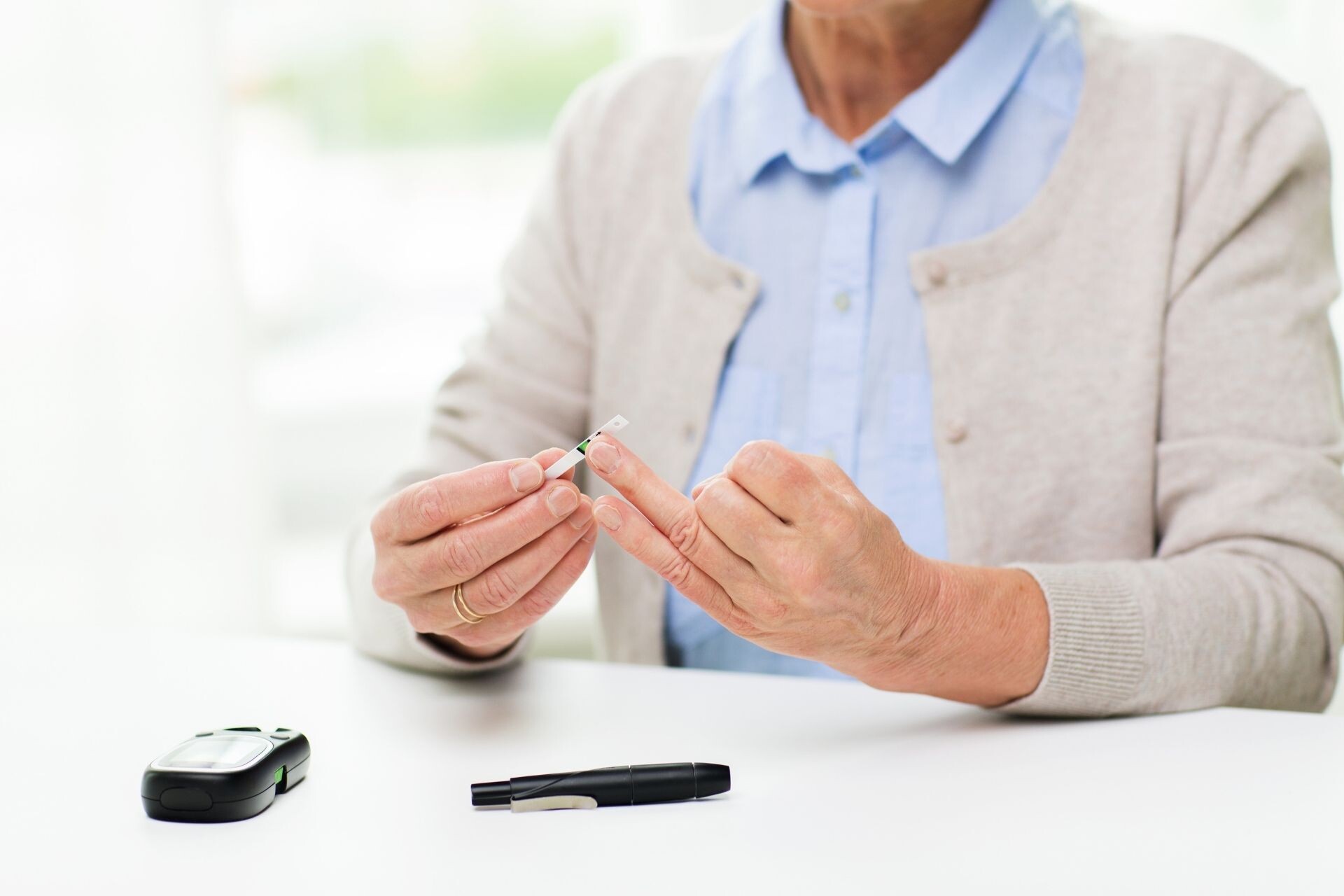In Germany, around a quarter of people aged over 65 suffer from type 2 diabetes – and the trend is rising. However, it is not only people with a known disease who should regularly check their blood sugar levels as they get older: Younger people are also increasingly affected. [1]
Poor blood glucose control in old age can have serious health consequences, including an increased risk of cardiovascular disease, cognitive impairment and increased mortality. [2,3] Active blood sugar management through a combination of drug therapy and lifestyle changes such as
What does the blood sugar value say?
The blood glucose level indicates the concentration of glucose in the blood and is an important indicator of the body's energy balance. It is subject to fluctuations during the course of the day, which are mainly influenced by food intake. The blood sugar level rises after eating, while it is at its lowest in the morning after getting up. In certain diseases, such as diabetes mellitus, the regulation of blood glucose levels is disturbed, which can lead to chronically increased or decreased blood glucose levels. [4]
Blood sugar: what is actually measured?
Blood glucose can be measured with blood glucose meters and is determined n. Blood glucose levels are usually expressed in either milligrams per deciliter (mg/dl) or millimoles per liter (mmol/l) . It is important to know both units, as they depend on the measuring devices used.
Nutrient blood sugar:
Indicates the glucose value after at least 8 hours of abstinence from food. Up to 5.6 mmol/l or 100mg/dl is considered normal for adults.
2-hour value (oGTT):
Measures the glucose utilization in the body after oral glucose administration, i.e. how well the body can process sugar.
HbA1c value:
Average long-term value of the blood glucose level over approx. 6-12 weeks. The value indicates how much excess sugar has bound itself to the red blood cells. Up to 5.6% or 38mmol/mol is considered normal in adults. Values above 6.5% or 48mmol/mol indicate diabetes and an increased risk of secondary diseases.
Normal blood sugar range for people aged 60 and over:
| Value | in mg/dl | in mmol/l |
| N blood glucose | < 100 | < 5.6 |
| 2h after eating | < 140 | < 7.6 |
Elevated blood sugar levels from 60 years of age:
| Value | Normal range | Prädiabetes | Diabetes mellitus |
| Nüchternblood glucose | < 100 mg/dl | 100–125 mg/dl | ≥ 126 mg/dl |
| 2h-value oGTT | < 140 mg/dl | 140–199 mg/dl | ≥ 200 mg/dl |
| HbA1c | < 5.7 % | 5.7–6.4 % | ≥ 6.5 % |
[4,5]
What happens when blood sugar is too high or too low?
A high blood sugar level is noticeable through various symptoms. Typical signs include severe thirst, frequent urination and general tiredness, which can have a major impact on everyday life. The following symptoms are a clear signal to check the blood sugar level and, if necessary, initiate treatment in order to avoid complications. [6]
Typical signs of elevated blood sugar levels (hyperglycaemia) are:
- Strong thirst (polydipsia) and dry mouth
- Frequent urination (polyuria)
- Thinness and poor performance
- Visual impairment
- Nausea and vomiting
- Smelly breath
- Abdominal pain and loss of appetite
- Depressed breathing (mouth breathing)
- Fights and changes in consciousness
Hypoglycemia, i.e. low blood sugar, is characterized by a number of symptoms that need to be treated quickly and effectively. These include trembling, sweating, restlessness, rapid heartbeat and confusion. Diabetics who are being treated with insulin should pay particular attention to these symptoms in order to be able to take immediate countermeasures, e.g. the intake of fast-acting sugar. [6]
Signs of low blood sugar (hypoglycaemia) include:
- Shaking and weakness
- Sweating
- Restlessness and nervousness
- Facial pallor
- heart palpitations
- Headache
- Confusion
- Visual disturbances
- Hunger
- In severe cases: Unconsciousness and stupor
Blood sugar management: What can I actively do?
Healthy nutrition
- The glycemic index (GI) and glycemic load (GL): Foods with a low GI and GL have less of an effect on blood sugar levels. Examples include wholegrain products, green leafy vegetables, apples and pulses. Foods with a high GI such as white bread, dried fruit and table sugar should be reduced.
- Recommendation: High-fiber meals, plenty of vegetables and protein, prefer complex carbohydrates, avoid fast food, reduce highly processed products and limit the consumption of alcoholic beverages. [7]
Regular movement
- Movement: Regular physical activity improves insulin sensitivity and promotes the uptake of glucose into cells, which lowers blood glucose levels .
- Recommendation: Moderate activity (e.g. 30 min. walks, gymnastics), muscle building exercises and endurance sports are ideal. The German Diabetes Association recommends being active for at least 150 minutes a week at a moderate intensity, for example by going for 30-minute walks at least five days a week. In addition, it is recommended to do strength training 2 to 3 times a week to maintain muscle mass and improve blood sugar control. [8]
Sleep & stress reduction
- Chronic stress: Stress can affect blood sugar regulation by promoting the release of stress hormones such as cortisol and adrenaline. These hormones can increase blood sugar levels and reduce insulin sensitivity. Recommendation: Stress management techniques such as regular relaxation exercises, meditation, yoga and sufficient sleep are therefore important and can provide a good balance in everyday life. [9]
Importance of regular blood glucose monitoring from the age of 60
The metabolism changes with age and the body's ability to produce and use insulin often decreases. This can lead to increased insulin resistance, even in the absence of a diabetes diagnosis. [10] Older people, especially those over the age of 60, have an increased risk of developing type 2 diabetes, even if they do not yet show any obvious symptoms. It is recommended to carry out regular blood sugar checks from this age in order to detect glucose intolerance or incipient diabetes at an early stage. A frequently recommended method for this is regular monitoring of the HbA1c value, which provides a long-term overview of the blood glucose level. [11]
Conclusion
Blood sugar is a critical health parameter in old age – and at the same time an influenceable risk factor. If you know your values, monitor them regularly and stabilize them through lifestyle measures, you can significantly reduce the risk of secondary diseases. The goal is not perfection, but a good balance between quality of life and metabolic health.
Literature references
[1] State Health Office Baden-Württemberg. (n. y.). Diabetes. Health department BW. Retrieved April 11, 2025, from https://www.gesundheitsamt-bw.de/lga/de/themen/praevention/diabetes/
[2] Tschöpe, D., Ringelstein, E. B., & Motz, W. (2024, June 5). Diabetes mellitus – heart disease – stroke. Diabetology Online. Retrieved April 11, 2025, from https://www.diabetologie-online.de/a/diabetes-mellitus-herzerkrankungen-schlaganfall-2512188
[3] Biessels, G. J., Deary, I. J., & Ryan, C. M. (2008). Cognition and diabetes: a lifespan perspective. The Lancet Neurology, 7(2), 184–190.
[4] Health Knowledge Foundation. (n.d.). Understanding laboratory values correctly. Retrieved April 11, 2025, from https://www.stiftung-gesundheitswissen.de/gesundes-leben/koerper-wissen/laborwerte-richtig-verstehen
[5] ADA (2023). Standards of Medical Care in Diabetes – 2023. Diabetes Care, 46(Supplement_1).
[6] German Diabetes Society. (2018). S3 guideline therapy of type 1 diabetes, 2ndedition.
[7] Long, M. T., & Fox, C. S. (2020). The role of diet in the prevention and management of type 2 diabetes mellitus: A review of the evidence. National Institutes of Health (NIH) / PubMed Central (PMC).
.[8] Brinkmann, C et al (2024). Diabetes, sport and exercise – DDG Practice Recommendation 2024. Diabetology and Metabolism, 19(S2), S279–S289.
.[9] Diabetes UK. (2019). Stress and diabetes | The impact on your wellbeing.
.[10] Kuo, C. L., et al. (2018). Age-related changes in insulin resistance and glucose metabolism: A longitudinal study. Diabetes Research and Clinical Practice, 145, 211-221.
.[11] Ziemer, D. C., et al (2015). Management of diabetes in older adults. Journal of Clinical Endocrinology & Metabolism, 100(4), 1096-1104.
.











